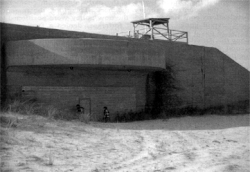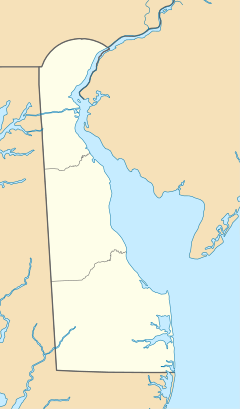Fort Miles
From Wikipedia, the free encyclopedia
Fort Miles Historic District
| |
 | |
Battery 519 at Fort Miles, Circa 1973
| |
|
| |
| Location | Cape Henlopen State Park, Sussex County |
|---|---|
| Nearest city | Lewes, Delaware |
| Coordinates | 38°46′50″N75°05′30″WCoordinates: 38°46′50″N 75°05′30″W |
| Built | 1940 |
| Architectural style | Other |
| Governing body | State |
| NRHP Reference # |
04001076
[1] |
| Added to NRHP | September 30, 2004 |
Fort Miles was an American military installation located on Cape Henlopen near Lewes, Delaware. Although funds to build the fort were approved in 1934, it was 1941 before the fort was constructed. It was built to defend Delaware Bay and River and to protect domestic shipping from enemy fire within the capes, particularly from the German surface fleet.
The fort was completed days before the attack on Pearl Harbor, Battery 118 (Smith) being declared operational on December 4, 1941. The United States declaration of war on Japan compelled the U. S. Army to man the fort with the 261st Coast Artillery Battalion, who days before were slated to leave. Fourteen vessels, including the USS Jacob Jones, a naval escort, were sunk off the coast of New Jersey during the first six months of 1942. Numerous batteries (ranging from 90mm guns up to 16 inch) were installed at the fort and a large mine field was laid in the waters off Lewes, Delaware in the following years, but the fort was to see no action during the conflict. The soldiers would receive the surrender of U-858, a German U-boat that was part of Operation Seawolf at the time of the German surrender to Allied forces in Europe. At its peak, Fort Miles was home to over 2,200 soldiers, men and women, including the261st Coast Artillery, the 21st Coast Artillery, the 52nd Coast Artillery (Railway), the 198th Coast Artillery(AA) and the 113th Infantry (det). Most of Fort Miles was declared surplus in 1948 and 1949, but the Army continued to use portions of it through the early 1990s as a recreation area under the management of Fort Meade. In 1963, the US Navy took control of the southern end of Fort Miles including Batteries Smith and Herring to establish a SOSUS listening facility. "NAVFAC Lewes" would continue to operate as a top secret facility there until September 30, 1981.
Fort Miles never saw any major action, only firing its guns once between its establishment and the end of the war. In 1964, 543 acres (2.2 km²) of federal land were donated to establish Cape Henlopen State Park. Over time, more land was transferred to the state park until Fort Miles ceased operation altogether in 1991. Its last official usage was as a bivouac for soldiers who had just returned from the first Gulf War.
Fire Control Towers, four to five story round-base concrete towers with flat observation decks, were set up as baselines to triangulate the position of suspicious ships or submarines. Five such towers still exist within the current boundaries of Cape Henlopen State Park, including one (#7) that has visitor access. Many bunkers were also constructed to house guns and other weapons. Barracks, administration buildings, and a pier were also constructed as part of the fort.
The four largest coastal Batteries at Ft. Miles are Battery 118 (Smith), Battery 221 (Herring), Battery 222 (Hunter), and Battery 519. Smith originally housed the two 16" guns, and is now in use by Cape Henlopen State Park for storage. Battery Herring, originally covered with sand like all the rest of the batteries, was excavated and expanded for use as a SOSUS station. It is now abandoned. Battery Hunter is in use currently as a Hawk Watch station. Battery 519 originally housed two 12" guns. It is currently being renovated for use as a museum, celebrating Delaware's part in World War II. Tours began in 2004. It has a restored 12" cannon similar to the original mounted at the south gun block. Additionally, it is being used to house a German built 20 millimeter anti-aircraft cannon that had been captured from U-858 after its surrender. Walking tours of the bunkers and other facilities currently being restored are available during summer weekends. The project falls under the pervue of the Delaware Department of Natural Resources and Environmental Control (DNREC). Historic interpreters can be seen at the park during special events. These events are designed to give the public a demonstration of military life at Fort Miles when it was still in operation.
Four Panama mounts still exist at Battery 22, located near the Beach House within the park.




No comments:
Post a Comment